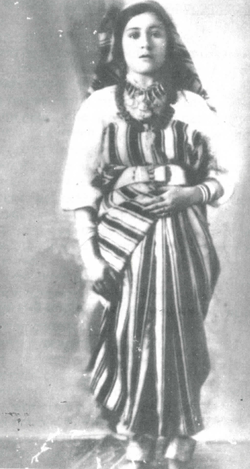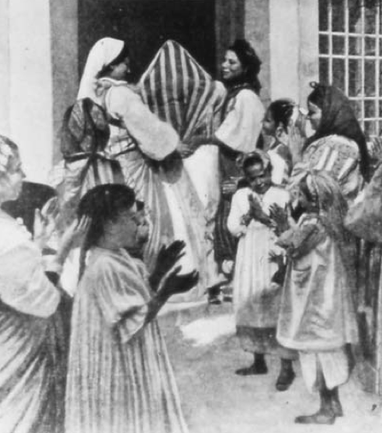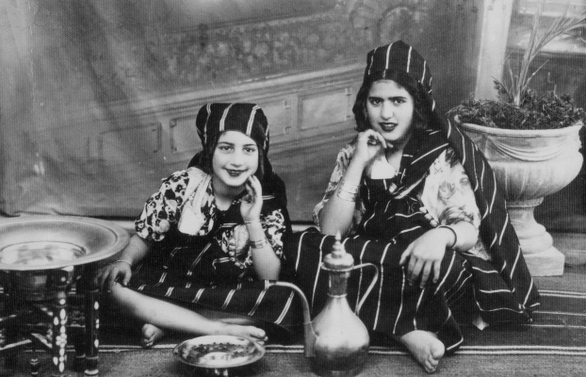If you are interested in having a traditional Jewish henna ceremony, for a marriage or for any other happy occasion, or interested in having me speak to a group about Jewish henna traditions, please contact me!
See here for an overview of Jewish henna traditions in general, and Jewish henna in Israel today.
This information is the result of my own research. Please do not copy this information without proper citation.
See here for an overview of Jewish henna traditions in general, and Jewish henna in Israel today.
This information is the result of my own research. Please do not copy this information without proper citation.
Jewish Henna Traditions in Libya
While the henna traditions of the Jews of Morocco are fairly well-established in literature, there is less known about henna traditions practiced by other Jewish communities in North Africa, in the modern countries of Algeria, Tunisia, and Libya.
The Libyan Jewish community, while very old, was fairly small compared to other parts of North Africa, and centred mainly in the cities of Tripoli and Benghazi. We have few colonial records of Libyan henna traditions, and even fewer of them deal with the Jewish community. A Jewish traveller, Elkan Adler wrote in The Advocate, a Jewish newpaper, in 1914 that the bride in Tripoli has her hands, feet, and hair hennaed, while her friends and relatives throw pieces of silver or gold money to her. Throughout the ceremony, she was expected to remain perfectly still and silent, with her eyes closed.

Libyan Jewish bride, 1920s
Avraham Elmalih, a Jerusalemite scholar, recorded his observations of a Tripolitanian henna ceremony in 1923: "An old woman, an expert in dyeing hair, takes the veil off her head, but [the bride] immediately covers her eyes with her hands so that she cannot see a thing that is happening around her. Two women undo her hair, while another two dye her hair with the henna dye, mixed into a thick paste. The bride lets them do as they please, and the dyeing picks up speed. the old women dye her, and the musicians sing and play drums, while the bride patiently suffers all the tortures in silence with eyes closed, while beads of sweat pour down like water from her face and forehead. When the ceremony reaches its climax, one of the musicians stands up holding a brass tray, and goes around to all the participants while singing; each one throws some coins into the tray". At the end of the ceremony she is brought to the house of the groom covered with a long veil and supported on either side by close friends.
Another rare record of Jewish life in Libya comes from Mordechai haCohen, a 19th century Tripolitanian rabbi, who attempted to catalogue the history and traditions of his community. He records that henna was grown locally and peddled by Jewish merchants, and he describes how the groom would send henna to the bride for the wedding henna ceremony, where the bride's hair, hands, and feet were hennaed in multiple stages.
While the bride was being hennaed, she sat over a hand mill and plow, spread with kerchiefs, to indicate her mastery of domestic activities like milling, gardening, and weaving.
Another rare record of Jewish life in Libya comes from Mordechai haCohen, a 19th century Tripolitanian rabbi, who attempted to catalogue the history and traditions of his community. He records that henna was grown locally and peddled by Jewish merchants, and he describes how the groom would send henna to the bride for the wedding henna ceremony, where the bride's hair, hands, and feet were hennaed in multiple stages.
While the bride was being hennaed, she sat over a hand mill and plow, spread with kerchiefs, to indicate her mastery of domestic activities like milling, gardening, and weaving.
Among Libyan Jews in modern times, as described in the colonial period, the bride was hennaed in stages: her hair was hennaed the Friday before and then again the following Sunday evening, and her hands and feet are hennaed on Monday and Tuesday (the evening before the wedding). They also practiced the ritual described above known as ar-rshoq (‘throwing [money]’), where young men would throw coins into a basket lying at the bride’s hennaed feet, or touch them to her feet, and then drop them in the basket. This served several functions; the young man, while throwing/dropping the coin, could quietly mention a woman’s name in whom he was interested; the women of the village would then later inquire to her eligibility, without the embarrassment of having the man begin a formal suit. The coins were also collected and given to the old woman running the ceremony as her payment.
Israeli anthropologist Harvey Goldberg adds an interesting anthropological analysis of the coin ceremony as enacting symbolic ‘penetration’ of the bride by all the men of the village, to whom the bride is hereafter forbidden. He bases this on the fact that the men would sometimes sharpen the coins and dig them into the bride’s feet (who is expected to stay motionless and silent), and the fact that the groom is not singled out in this ceremony.
Many aspects of the Libyan Jewish wedding are similar to those of the Djerban Jews, and some sources suggest that a resist technique similar to that practiced by the Jews of Djerba was done by Libyan Jews as well.
Israeli anthropologist Harvey Goldberg adds an interesting anthropological analysis of the coin ceremony as enacting symbolic ‘penetration’ of the bride by all the men of the village, to whom the bride is hereafter forbidden. He bases this on the fact that the men would sometimes sharpen the coins and dig them into the bride’s feet (who is expected to stay motionless and silent), and the fact that the groom is not singled out in this ceremony.
Many aspects of the Libyan Jewish wedding are similar to those of the Djerban Jews, and some sources suggest that a resist technique similar to that practiced by the Jews of Djerba was done by Libyan Jews as well.
Sources and References:
Adler, Elkan. 1914 Some Quaint Jewish Customs. The Advocate: America’s Jewish Journal, Vol. 48.
Buaron, Zevulun. 1994 Minhagei ḥatuna beqehilot Luv [Wedding customs among the communities of Libya].
Elmalih, Avraham. 1923 Ḥatuna yehudit beTripoli [A Jewish wedding in Tripoli]. Hed Yerushalayim.
Goldberg, Harvey. 1972 Cave Dwellers and Citrus Growers: a Jewish community in Libya and Israel.
Goldberg, Harvey. 1990 Jewish Life in Muslim Libya: Rivals and Relatives.
HaKohen, Mordechai 1993 The book of Mordechai: a study of the Jews of Libya [edited and translated by Harvey Goldberg].
Buaron, Zevulun. 1994 Minhagei ḥatuna beqehilot Luv [Wedding customs among the communities of Libya].
Elmalih, Avraham. 1923 Ḥatuna yehudit beTripoli [A Jewish wedding in Tripoli]. Hed Yerushalayim.
Goldberg, Harvey. 1972 Cave Dwellers and Citrus Growers: a Jewish community in Libya and Israel.
Goldberg, Harvey. 1990 Jewish Life in Muslim Libya: Rivals and Relatives.
HaKohen, Mordechai 1993 The book of Mordechai: a study of the Jews of Libya [edited and translated by Harvey Goldberg].

